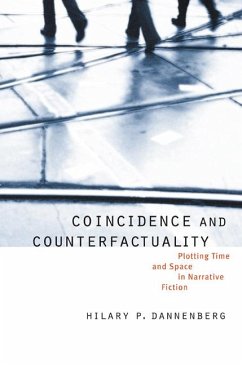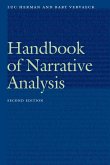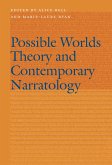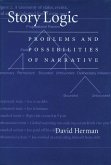- Gebundenes Buch
- Merkliste
- Auf die Merkliste
- Bewerten Bewerten
- Teilen
- Produkt teilen
- Produkterinnerung
- Produkterinnerung
While plot is among the integral aspects of storytelling, it is perhaps the least studied aspect of narrative. Using plot theory to chart the development of narrative fiction from the Renaissance to the present, this title demonstrates how the novel has evolved over time and how writers have developed increasingly complex narrative strategies.
Andere Kunden interessierten sich auch für
![Fictional Minds Fictional Minds]() Alan PalmerFictional Minds24,99 €
Alan PalmerFictional Minds24,99 €![Handbook of Narrative Analysis Handbook of Narrative Analysis]() Luc HermanHandbook of Narrative Analysis42,99 €
Luc HermanHandbook of Narrative Analysis42,99 €![Possible Worlds Theory and Contemporary Narratology Possible Worlds Theory and Contemporary Narratology]() Alice BellPossible Worlds Theory and Contemporary Narratology57,99 €
Alice BellPossible Worlds Theory and Contemporary Narratology57,99 €![Narrative Across Media Narrative Across Media]() Marie-Laure RyanNarrative Across Media41,99 €
Marie-Laure RyanNarrative Across Media41,99 €![Story Logic Story Logic]() David HermanStory Logic52,99 €
David HermanStory Logic52,99 €![Synchronicity Synchronicity]() Joseph JaworskiSynchronicity31,99 €
Joseph JaworskiSynchronicity31,99 €![Cyberpunk 2077: No Coincidence Cyberpunk 2077: No Coincidence]() Rafal KosikCyberpunk 2077: No Coincidence9,99 €
Rafal KosikCyberpunk 2077: No Coincidence9,99 €-
-
-
While plot is among the integral aspects of storytelling, it is perhaps the least studied aspect of narrative. Using plot theory to chart the development of narrative fiction from the Renaissance to the present, this title demonstrates how the novel has evolved over time and how writers have developed increasingly complex narrative strategies.
Produktdetails
- Produktdetails
- Frontiers of Narrative
- Verlag: University of Nebraska Press
- Seitenzahl: 304
- Erscheinungstermin: 1. Juli 2008
- Englisch
- Abmessung: 235mm x 167mm x 26mm
- Gewicht: 634g
- ISBN-13: 9780803210936
- ISBN-10: 0803210930
- Artikelnr.: 23354749
- Herstellerkennzeichnung
- Libri GmbH
- Europaallee 1
- 36244 Bad Hersfeld
- gpsr@libri.de
- Frontiers of Narrative
- Verlag: University of Nebraska Press
- Seitenzahl: 304
- Erscheinungstermin: 1. Juli 2008
- Englisch
- Abmessung: 235mm x 167mm x 26mm
- Gewicht: 634g
- ISBN-13: 9780803210936
- ISBN-10: 0803210930
- Artikelnr.: 23354749
- Herstellerkennzeichnung
- Libri GmbH
- Europaallee 1
- 36244 Bad Hersfeld
- gpsr@libri.de
Hilary P. Dannenberg is a professor of English Literature at the University of Trier in Germany.
List of Figures
Preface
Introduction
1. Convergent and Divergent Plots and Character Trajectories
2. A Brief History of Approaches to Plot and Related Theories
3. A Guide to this Study and its Research Contribution
Part I: Plotting Time and Space in Narrative Fiction
1. Cognitive Plotting: Crossing Narrative Boundaries and Connecting Worlds
1. Liberation and Belief in Narrative Fiction
2. World Construction: The Plotting Principle
3. Narrative Suspense and Liminal Plotting
4. Conclusion: Possible and Impossible Worlds
2. Ontological Plotting: Narrative as a Multiplicity of Temporal Dimensions
1. Plot as the Sum of Alternate Possible Worlds
2. Counterfactual Worlds
3. Counterfactuality, Transworld Identity, and World-Blending
4. Ontological Hierarchies in Realist and Other Fictions
3. Spatial Plotting: Paths, Links, and Portals
1. The Spatial Mapping of Time and Narrative
2. The Cognitive Schemata of Bodily Orientation in Fictional Space
Part II: Theorizing Coincidence and Counterfactuality
4. The Coincidence Plot
1. Coincidence in Literature and Science
2. The Traditional Coincidence Plot in Narrative Fiction
3. Analogical Coincidence
5. Counterfactuals and Other Alternate Narrative Worlds
1. Counterfactuals Across the Disciplines
2. A Theory of Counterfactuals in Narrative Fiction
3. Key Forms of Counterfactual in Narrative Fiction
4. Beyond the Counterfactual: Multiple Alternate Worlds
Part III: Coincidence and Counterfactuality in the History of Narrative
Fiction
Introduction
6. The Metamorphoses of the Coincidence Plot
1. Discordant and Euphoric Recognition in the Renaissance Romance
2. Recognition and Identity in the Developing Novel
3. The Hyperconvergence of the Fictional Victorians
4. Analogous and Traditional Coincidence in Modernist Fiction
5. The Postmodern Renaissance of the Coincidence Plot
7. The Narrative Evolution of Counterfactuals
1. From Renaissance Rhetoric towards Realist Counterfactuals
2. Autobiographical Counterfactuals in Eighteenth-Century Fiction
3. Counterfactuals in Eighteenth-Century Heterodiegetic Narration
4. Alternate Lives and Loves in Nineteenth-Century Fiction
5. The Multiplication of Time: Alternate History in Nineteenth and
Twentieth-Century Fiction
6. Counterfactual Fantasies, Metafictions, and Metahistories in
Twentieth-Century Fiction
Conclusion
Glossary of Key Terms
Works Cited
Preface
Introduction
1. Convergent and Divergent Plots and Character Trajectories
2. A Brief History of Approaches to Plot and Related Theories
3. A Guide to this Study and its Research Contribution
Part I: Plotting Time and Space in Narrative Fiction
1. Cognitive Plotting: Crossing Narrative Boundaries and Connecting Worlds
1. Liberation and Belief in Narrative Fiction
2. World Construction: The Plotting Principle
3. Narrative Suspense and Liminal Plotting
4. Conclusion: Possible and Impossible Worlds
2. Ontological Plotting: Narrative as a Multiplicity of Temporal Dimensions
1. Plot as the Sum of Alternate Possible Worlds
2. Counterfactual Worlds
3. Counterfactuality, Transworld Identity, and World-Blending
4. Ontological Hierarchies in Realist and Other Fictions
3. Spatial Plotting: Paths, Links, and Portals
1. The Spatial Mapping of Time and Narrative
2. The Cognitive Schemata of Bodily Orientation in Fictional Space
Part II: Theorizing Coincidence and Counterfactuality
4. The Coincidence Plot
1. Coincidence in Literature and Science
2. The Traditional Coincidence Plot in Narrative Fiction
3. Analogical Coincidence
5. Counterfactuals and Other Alternate Narrative Worlds
1. Counterfactuals Across the Disciplines
2. A Theory of Counterfactuals in Narrative Fiction
3. Key Forms of Counterfactual in Narrative Fiction
4. Beyond the Counterfactual: Multiple Alternate Worlds
Part III: Coincidence and Counterfactuality in the History of Narrative
Fiction
Introduction
6. The Metamorphoses of the Coincidence Plot
1. Discordant and Euphoric Recognition in the Renaissance Romance
2. Recognition and Identity in the Developing Novel
3. The Hyperconvergence of the Fictional Victorians
4. Analogous and Traditional Coincidence in Modernist Fiction
5. The Postmodern Renaissance of the Coincidence Plot
7. The Narrative Evolution of Counterfactuals
1. From Renaissance Rhetoric towards Realist Counterfactuals
2. Autobiographical Counterfactuals in Eighteenth-Century Fiction
3. Counterfactuals in Eighteenth-Century Heterodiegetic Narration
4. Alternate Lives and Loves in Nineteenth-Century Fiction
5. The Multiplication of Time: Alternate History in Nineteenth and
Twentieth-Century Fiction
6. Counterfactual Fantasies, Metafictions, and Metahistories in
Twentieth-Century Fiction
Conclusion
Glossary of Key Terms
Works Cited
List of Figures
Preface
Introduction
1. Convergent and Divergent Plots and Character Trajectories
2. A Brief History of Approaches to Plot and Related Theories
3. A Guide to this Study and its Research Contribution
Part I: Plotting Time and Space in Narrative Fiction
1. Cognitive Plotting: Crossing Narrative Boundaries and Connecting Worlds
1. Liberation and Belief in Narrative Fiction
2. World Construction: The Plotting Principle
3. Narrative Suspense and Liminal Plotting
4. Conclusion: Possible and Impossible Worlds
2. Ontological Plotting: Narrative as a Multiplicity of Temporal Dimensions
1. Plot as the Sum of Alternate Possible Worlds
2. Counterfactual Worlds
3. Counterfactuality, Transworld Identity, and World-Blending
4. Ontological Hierarchies in Realist and Other Fictions
3. Spatial Plotting: Paths, Links, and Portals
1. The Spatial Mapping of Time and Narrative
2. The Cognitive Schemata of Bodily Orientation in Fictional Space
Part II: Theorizing Coincidence and Counterfactuality
4. The Coincidence Plot
1. Coincidence in Literature and Science
2. The Traditional Coincidence Plot in Narrative Fiction
3. Analogical Coincidence
5. Counterfactuals and Other Alternate Narrative Worlds
1. Counterfactuals Across the Disciplines
2. A Theory of Counterfactuals in Narrative Fiction
3. Key Forms of Counterfactual in Narrative Fiction
4. Beyond the Counterfactual: Multiple Alternate Worlds
Part III: Coincidence and Counterfactuality in the History of Narrative
Fiction
Introduction
6. The Metamorphoses of the Coincidence Plot
1. Discordant and Euphoric Recognition in the Renaissance Romance
2. Recognition and Identity in the Developing Novel
3. The Hyperconvergence of the Fictional Victorians
4. Analogous and Traditional Coincidence in Modernist Fiction
5. The Postmodern Renaissance of the Coincidence Plot
7. The Narrative Evolution of Counterfactuals
1. From Renaissance Rhetoric towards Realist Counterfactuals
2. Autobiographical Counterfactuals in Eighteenth-Century Fiction
3. Counterfactuals in Eighteenth-Century Heterodiegetic Narration
4. Alternate Lives and Loves in Nineteenth-Century Fiction
5. The Multiplication of Time: Alternate History in Nineteenth and
Twentieth-Century Fiction
6. Counterfactual Fantasies, Metafictions, and Metahistories in
Twentieth-Century Fiction
Conclusion
Glossary of Key Terms
Works Cited
Preface
Introduction
1. Convergent and Divergent Plots and Character Trajectories
2. A Brief History of Approaches to Plot and Related Theories
3. A Guide to this Study and its Research Contribution
Part I: Plotting Time and Space in Narrative Fiction
1. Cognitive Plotting: Crossing Narrative Boundaries and Connecting Worlds
1. Liberation and Belief in Narrative Fiction
2. World Construction: The Plotting Principle
3. Narrative Suspense and Liminal Plotting
4. Conclusion: Possible and Impossible Worlds
2. Ontological Plotting: Narrative as a Multiplicity of Temporal Dimensions
1. Plot as the Sum of Alternate Possible Worlds
2. Counterfactual Worlds
3. Counterfactuality, Transworld Identity, and World-Blending
4. Ontological Hierarchies in Realist and Other Fictions
3. Spatial Plotting: Paths, Links, and Portals
1. The Spatial Mapping of Time and Narrative
2. The Cognitive Schemata of Bodily Orientation in Fictional Space
Part II: Theorizing Coincidence and Counterfactuality
4. The Coincidence Plot
1. Coincidence in Literature and Science
2. The Traditional Coincidence Plot in Narrative Fiction
3. Analogical Coincidence
5. Counterfactuals and Other Alternate Narrative Worlds
1. Counterfactuals Across the Disciplines
2. A Theory of Counterfactuals in Narrative Fiction
3. Key Forms of Counterfactual in Narrative Fiction
4. Beyond the Counterfactual: Multiple Alternate Worlds
Part III: Coincidence and Counterfactuality in the History of Narrative
Fiction
Introduction
6. The Metamorphoses of the Coincidence Plot
1. Discordant and Euphoric Recognition in the Renaissance Romance
2. Recognition and Identity in the Developing Novel
3. The Hyperconvergence of the Fictional Victorians
4. Analogous and Traditional Coincidence in Modernist Fiction
5. The Postmodern Renaissance of the Coincidence Plot
7. The Narrative Evolution of Counterfactuals
1. From Renaissance Rhetoric towards Realist Counterfactuals
2. Autobiographical Counterfactuals in Eighteenth-Century Fiction
3. Counterfactuals in Eighteenth-Century Heterodiegetic Narration
4. Alternate Lives and Loves in Nineteenth-Century Fiction
5. The Multiplication of Time: Alternate History in Nineteenth and
Twentieth-Century Fiction
6. Counterfactual Fantasies, Metafictions, and Metahistories in
Twentieth-Century Fiction
Conclusion
Glossary of Key Terms
Works Cited








